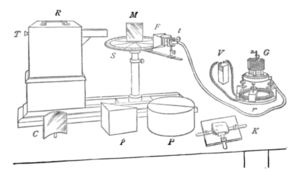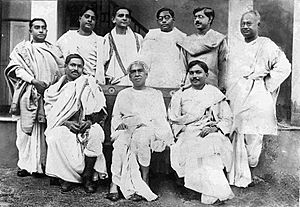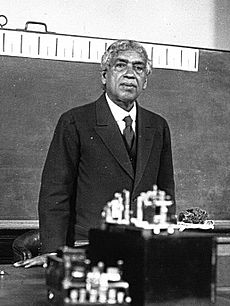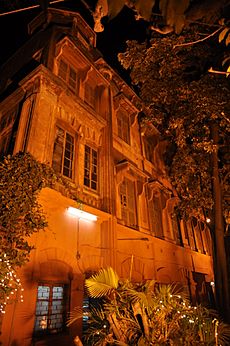Jagadish Chandra Bose facts for kids
Quick facts for kids
Jagadish Chandra Bose
|
|
|---|---|
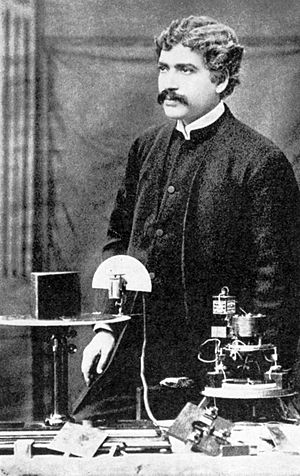
Jagadish Chandra Bose in Royal Institution, London, 1897
|
|
| Born | 30 November 1858 |
| Died | 23 November 1937 (aged 78) Giridih, Bengal Presidency, British India (now Giridih, Jharkhand, India)
|
| Alma mater | St. Xavier's College, Calcutta (BA) Christ's College, Cambridge (BA) University College London (BSc, DSc) |
| Known for | Millimetre waves Radio Crescograph Contributions to botany Crystal radio Crystal detector |
| Spouse(s) | Abala Bose |
| Awards | Companion of The Order of the Indian Empire (CIE) (1903) Companion of the Order of the Star of India (CSI) (1911) Knight Bachelor (1917) |
| Scientific career | |
| Fields | Physics, biophysics, biology, botany |
| Institutions | University of Calcutta University of Cambridge University of London |
| Academic advisors | John Strutt (Rayleigh) |
| Notable students | Satyendra Nath Bose Meghnad Saha Prasanta Chandra Mahalanobis Sisir Kumar Mitra Debendra Mohan Bose |
| Signature | |
Sir Jagadish Chandra Bose (born November 30, 1858 – died November 23, 1937) was an amazing scientist from India. He was interested in many fields, like biology, physics, and botany. He even wrote science fiction stories!
Bose was a pioneer in studying radio waves, especially tiny "microwaves". He also made big contributions to understanding plants. He helped science grow a lot in India. Many people call him the father of Bengali science fiction. He invented the crescograph, a special tool to measure how plants grow. There is even a crater on the Moon named after him! In 1917, he started the Bose Institute, which was the first research center in Asia to study many different science topics. He was the director of this institute until he passed away.
Jagadish Chandra Bose was born in Munshiganj, which was then part of British India (now in Bangladesh). He studied at St. Xavier's College, Calcutta in Kolkata. He first went to University of London to study medicine, but he had to stop because of health problems. Instead, he did research with Nobel Laureate Lord Rayleigh at the University of Cambridge.
Later, Bose returned to India and became a physics professor at Presidency College in University of Calcutta. Even though he faced challenges like discrimination and a lack of money and equipment, he kept doing his scientific research. He made important discoveries about radio waves. He was also the first to use semiconductor materials to detect radio waves.
Bose made new discoveries about how plants work. He used his invention, the crescograph, to see how plants react to different things. He showed that plants and animals have similar ways of responding to their surroundings. Bose also studied how microwaves affect plant tissues. He wrote books like Response in the Living and Non-Living (1902).
Contents
Early Life and Education
Jagadish Chandra Bose was born on November 30, 1858. His family was Bengali Kayastha. His father, Bhagawan Chandra Bose, was a civil servant. He worked as a Deputy Magistrate and Assistant Commissioner of Police.
Bose's father wanted him to learn about his own language and culture first. So, he sent Jagadish to a Bengali language school for his early education.
In 1869, Bose went to the Hare School in Kolkata. Then he went to St. Xavier's School. In 1875, he passed the entrance exam for the University of Calcutta. He then joined St. Xavier's College. There, he met Father Eugene Lafont, a Jesuit priest. Father Lafont helped Bose become very interested in natural sciences. Bose earned a BA degree from the University of Calcutta in 1879.
Bose wanted to join the Indian Civil Service, like his father. But his father wanted him to be a scholar who would "rule nobody but himself." So, Bose went to England to study medicine at the University of London. However, he had to stop studying medicine because of allergies and poor health.
With help from his brother-in-law, Anandamohan Bose, Jagadish got into Christ's College, Cambridge. There, he studied natural sciences. In 1884, he received a BA from the University of Cambridge. He also got a BSc from University College London in 1883.
Some of his teachers at Cambridge were famous scientists like Lord Rayleigh and James Dewar. While studying, he became good friends with Prafulla Chandra Roy. In 1887, Bose married Abala Bose, who was a feminist and social worker.
Professor at Presidency College
After finishing his studies in Cambridge, Bose came back to India. He was recommended for a teaching job in Kolkata. In those days, these jobs were usually given to Europeans. But Bose was appointed as a physics professor at Presidency College in January 1885.
At first, an Indian professor was paid less than a European professor. Bose was paid only one-third of what his European colleagues earned. As a protest, he refused to take his salary for the first three years.
He was a very popular teacher. Students liked his teaching style and how he showed experiments. After three years, the college recognized his hard work. His appointment became permanent, and he received all the salary he had refused earlier.
Bose often used his own money to pay for his research projects. He also received support from the social activist Sister Nivedita.
Microwave Radio Research
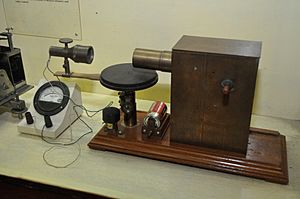
Bose became interested in radio waves after learning about Oliver Lodge's work in 1894. He started his own research in November 1894. He set up his equipment in a small room at Presidency College. He wanted to study how radio waves act like light. To do this, he made the waves very small, down to the millimetre level (about 5 mm long).
At first, his department at the college did not support his research. They thought he should only focus on teaching. But later, the scientific community became interested. The government offered him a grant to help with his research. Even with the grant, Bose found it hard to find enough time for research because of his teaching duties.
In May 1895, Bose sent his first scientific paper to the Asiatic Society of Bengal. In October 1895, he sent another paper to the Royal Society of London. This paper described his plans for a "coherer," which is a device used to detect radio waves.
In November 1895, Bose gave a public demonstration in Kolkata. He showed how his tiny microwaves could travel through a person's body and through two walls. The waves then made a bell ring and ignited gunpowder in a closed room. This was a very impressive demonstration!
In 1896, Bose went to London for a lecture tour. He met Guglielmo Marconi, another inventor who was working on wireless telegraphy. Bose was also congratulated by Lord Kelvin and received an honorary Doctor of Science degree. Bose said he was not interested in making money from his inventions. He wanted others to use his research freely.
In 1899, Bose announced a new type of "coherer" that used iron and mercury. He presented this to the Royal Society in London.
Bose's Place in Radio Development
Bose's work on radio microwaves was mainly to understand how they work. He was not trying to create a communication system. At the same time, Marconi was developing a radio system for sending messages wirelessly. Other scientists, like Alexander Stepanovich Popov, were also finding practical uses for radio waves.
Bose was not interested in getting patents for his work. He openly shared how his inventions, like the galena crystal detector, worked. Even though he didn't patent much, his work influenced other inventors.
Bose was the first to use a semiconductor to detect radio waves. He also invented many microwave parts that are still used today. In 1954, scientists recognized Bose for being the first to use a semi-conducting crystal for radio wave detection. Much of his original equipment is still at the Bose Institute in Kolkata.
Sir Nevill Mott, a Nobel Prize winner, said that "J.C. Bose was at least 60 years ahead of his time." He believed Bose had predicted the existence of P-type and N-type semiconductors.
Plant Research
Bose did most of his plant studies on plants like Mimosa pudica (the touch-me-not plant) and Desmodium gyrans (the telegraph plant). His biggest discovery in biophysics was showing that plants use electrical signals to respond to things. Before him, people thought these responses were only chemical.
To understand how plants move towards light (called heliotropism), Bose invented a special recorder. He found that when light hit one side of a sunflower, the other side would swell up. He also studied how microwaves affected plant tissues. He researched how seasons, chemicals, and temperature changed plant responses. He even suggested that injured plants might have a "power of feeling." His books include The Nervous Mechanism of Plants (1926).
Science Fiction Writing
In 1896, Bose wrote a short story called Niruddesher Kahini (The Story of the Missing One). This story was later made longer and added to a collection called Abyakta in 1921. It was renamed Palatak Tuphan (Runaway Cyclone). This was one of the very first Bengali science fiction stories ever written.
Bose Institute
In 1917, Bose founded the Bose Institute in Kolkata. He was its Director for the first twenty years, until his death. Today, it is a very important and old research institute in India.
Legacy and Honors
Jagadish Chandra Bose's work has been recognized more and more over time. His discoveries likely helped in the development of radio communication. He is also known for finding millimetre-length electromagnetic waves and for being a pioneer in biophysics.
Many of his original instruments are still on display today. They are still largely usable, even after more than 100 years! These include different antennas, polarisers, and waveguides, which are still used in modern technology.
To celebrate 100 years since his birth in 1958, the JBNSTS scholarship program was started in West Bengal. In the same year, India released a postage stamp with his picture. Several documentary films have also been made about his life and work.
On September 14, 2012, Bose's work on millimetre-band radio was recognized as an IEEE Milestone. This was the first time such a discovery in India received this honor. On November 30, 2016, Google Doodle celebrated his 158th birthday. He was also considered for the design of the 50 UK Pound currency note for his pioneering work related to Wi-Fi technology.
Honors
- Companion of the Order of the Indian Empire (CIE) – 1903
- Companion of the Order of the Star of India (CSI) – 1912
- Knight Bachelor – 1917
- Fellow of the Royal Society (FRS) – 1920
- Member of the Vienna Academy of Sciences – 1928
- President of the 14th session of the Indian Science Congress – 1927
- Member of Finnish Society of Sciences and Letters – 1929
- Member of the League of Nations' Committee for Intellectual Cooperation – 1924 to 1931
- Founding fellow of the National Institute of Sciences of India (now the Indian National Science Academy)
Legacy
- The J.C. Bose University of Science and Technology, YMCA is named in his honor.
- The Indian Botanic Garden was renamed the Acharya Jagadish Chandra Bose Indian Botanic Garden in 2009.
- In 2004, Bose was ranked 7th in a BBC poll for the Greatest Bengali of all time.
See also
 In Spanish: Jagdish Chandra Bose para niños
In Spanish: Jagdish Chandra Bose para niños


